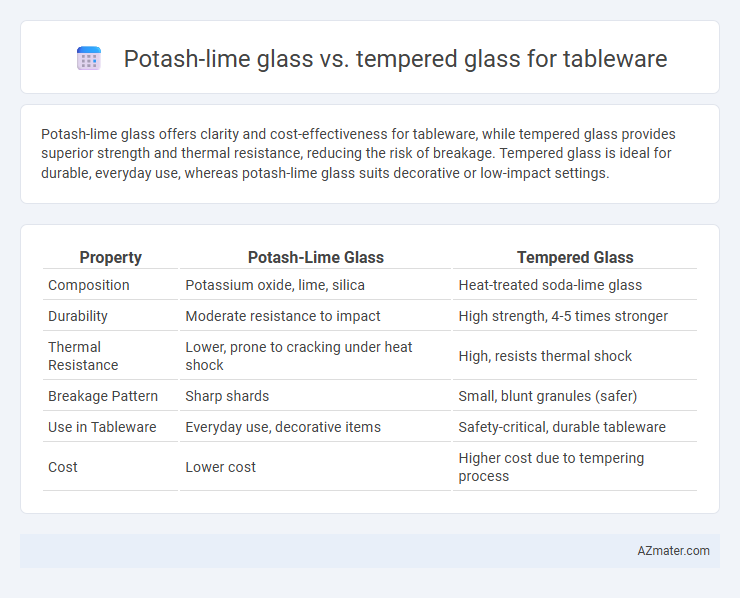Potash-lime glass offers clarity and cost-effectiveness for tableware, while tempered glass provides superior strength and thermal resistance, reducing the risk of breakage. Tempered glass is ideal for durable, everyday use, whereas potash-lime glass suits decorative or low-impact settings.
Table of Comparison
| Property | Potash-Lime Glass | Tempered Glass |
|---|---|---|
| Composition | Potassium oxide, lime, silica | Heat-treated soda-lime glass |
| Durability | Moderate resistance to impact | High strength, 4-5 times stronger |
| Thermal Resistance | Lower, prone to cracking under heat shock | High, resists thermal shock |
| Breakage Pattern | Sharp shards | Small, blunt granules (safer) |
| Use in Tableware | Everyday use, decorative items | Safety-critical, durable tableware |
| Cost | Lower cost | Higher cost due to tempering process |
Introduction to Potash-Lime Glass and Tempered Glass
Potash-lime glass, commonly used in tableware, offers excellent clarity, chemical durability, and resistance to thermal shock, making it ideal for everyday use. Tempered glass, produced by controlled thermal or chemical treatment, significantly enhances strength and safety by breaking into small, blunt pieces upon impact, reducing injury risk. Understanding the structural and mechanical differences between potash-lime and tempered glass is essential for selecting appropriate tableware based on durability and safety requirements.
Chemical Composition Differences
Potash-lime glass for tableware primarily contains silica, potash (potassium oxide), lime (calcium oxide), and smaller amounts of soda (sodium oxide), which provide moderate chemical durability and thermal resistance. Tempered glass is typically made from soda-lime composition with additional controlled heat treatment, increasing its strength and changing its internal stress structure without significantly altering the basic chemical components. The main chemical composition difference lies in the higher potassium oxide content in potash-lime glass, while tempered glass relies on a soda-lime base enhanced by tempering techniques rather than chemical additives.
Manufacturing Processes Compared
Potash-lime glass for tableware is produced through a slower melting process that involves raw materials like sand, potash, and lime, resulting in a softer, more workable glass. Tempered glass undergoes an additional heat treatment process where the glass is rapidly heated to around 620degC and then quenched with cold air, inducing compressive stresses that enhance its strength and resistance to thermal shock. The distinct manufacturing techniques directly influence the durability, safety, and performance properties, with tempered glass offering superior mechanical strength compared to the more traditional potash-lime glass.
Strength and Durability: Which is Superior?
Tempered glass exhibits superior strength and durability compared to potash-lime glass due to its heat-treatment process, which increases resistance to impact and thermal shock. Potash-lime glass, while offering good clarity and chemical stability, is more prone to chipping and breaking under stress. For tableware that requires longevity and safety, tempered glass is the preferred choice because it withstands daily use and accidental drops more effectively.
Heat Resistance and Thermal Shock Performance
Potash-lime glass used in tableware offers moderate heat resistance, suitable for everyday use but prone to cracking under sudden temperature changes due to its low thermal shock resistance. Tempered glass exhibits significantly higher heat resistance and superior thermal shock performance, making it ideal for handling rapid temperature fluctuations without breaking. The tempering process enhances the glass's structural integrity, ensuring durability and safety during exposure to hot liquids or direct heat.
Aesthetic Qualities and Design Flexibility
Potash-lime glass offers superior clarity and a smooth, polished surface that enhances the visual appeal of tableware with elegant, delicate designs. Tempered glass provides enhanced strength and durability but tends to have a slightly thicker profile and less optical clarity, limiting intricate aesthetic detailing. Designers prefer potash-lime glass for creative freedom and refined textures, while tempered glass is chosen for robust, functional pieces requiring increased safety.
Safety Features for Tableware Applications
Potash-lime glass, commonly used in tableware, offers moderate strength but is prone to shattering into sharp shards upon impact, posing a safety risk. Tempered glass undergoes heat treatment that increases its strength by up to five times and shatters into small, blunt granules rather than sharp pieces, significantly enhancing safety for everyday use. The superior impact resistance and reduced risk of injury make tempered glass the preferred choice for safer tableware applications.
Cost Implications and Market Availability
Potash-lime glass is generally more cost-effective than tempered glass, making it a popular choice for budget-friendly tableware due to its lower production expenses. Tempered glass offers superior strength and safety but comes at a higher price, limiting its availability primarily to higher-end or specialized markets. Market availability favors potash-lime glass in mass-produced tableware, while tempered glass is more common in premium or commercial-grade products where durability is critical.
Environmental Impact and Recyclability
Potash-lime glass, commonly used in tableware, has a lower environmental impact due to its energy-efficient production process and high recyclability, as it can be repeatedly melted and reformed without quality loss. Tempered glass, while mechanically stronger, undergoes a heat treatment that complicates recycling because it shatters into small pieces that are harder to reprocess. The straightforward recyclability of potash-lime glass makes it a more sustainable choice for eco-conscious tableware manufacturing and disposal.
Choosing the Right Glassware for Your Table
Potash-lime glass and tempered glass each offer unique benefits for tableware: potash-lime glass is known for its clarity, affordability, and ease of molding, making it ideal for everyday use. Tempered glass, strengthened through controlled thermal processes, provides superior durability and resistance to thermal shock, ensuring safety and longevity in high-traffic dining settings. Selecting the right glassware involves balancing budget considerations with desired durability and use frequency, where tempered glass excels in robustness while potash-lime glass offers aesthetic versatility.

Infographic: Potash-lime glass vs Tempered glass for Tableware
 azmater.com
azmater.com